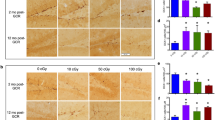Abstract
Hippocampal precursors retain the capacity to proliferate and differentiate throughout life, and their progeny, immature neurons, can undergo neurogenesis, a process believed to be important in maintaining the cognitive health of an organism. A variety of stresses including irradiation have been shown to deplete neural precursor cells, an effect that inhibits neurogenesis and is associated with the onset of cognitive impairments. Our past work has shown that neural precursor cells exposed to X-rays or protons exhibit a prolonged increase in oxidative stress, a factor we hypothesize to be critical in regulating the function of these cells after irradiation and other stresses. Here we report that irradiation of hippocampal precursor cells with high-linear energy transfer (LET) 1 GeV/nucleon 56Fe ions leads to significantly higher levels of oxidative stress when compared to lower LET radiations (X-rays, protons). Irradiation with 1 Gy of 56Fe ions elicits twofold to fivefold higher levels of reactive oxygen species (ROS) compared to unirradiated controls, and at lower doses (≤1 Gy) neural precursors exhibit a linear dose response 6 h after heavy ion exposure. The use of the antioxidant lipoic acid (LA) was able to reduce ROS levels below background levels when added before or after 56Fe ion irradiation. These results conclusively show that low doses of 56Fe ions can elicit significant levels of oxidative stress in neural precursor cells. Given the prevalence of heavy ions in space and the duration of interplanetary travel, these data suggest that astronauts are at risk for developing cognitive decrements. However, our results also indicate that antioxidants delivered before as radioprotective agents or after as mitigating agents hold promise as effective countermeasures for ameliorating certain adverse effects of heavy ion exposure to the CNS.




Similar content being viewed by others
Abbreviations
- CM-H2DCFDA:
-
5-(and-6)-Chloromethyl-2′,7′-dichlorodihydrofluorescein diacetate
- FACS:
-
Fluorescent activated cell sorting
- SGZ:
-
Subgranular zone of the dentate gyrus
- ROS:
-
Reactive oxygen species
References
Cucinotta FA, Durante M (2006) Cancer risk from exposure to galactic cosmic rays: implications for space exploration by human beings. Lancet Oncol 7:431–435
Cucinotta FA, Schimmerling W, Wilson JW, Peterson LE, Badhwar GD, Saganti PB, Dicello JF (2001) Space radiation cancer risks and uncertainties for Mars missions. Radiat Res 156:682–688
Wilson JW, Clowdsley MS, Cucinotta FA, Tripathi RK, Nealy JE, De Angelis G (2004) Deep space environments for human exploration. Adv Space Res 34:1281–1287
Monje ML, Toda H, Palmer TD (2003) Inflammatory blockade restores adult hippocampal neurogenesis. Science 302:1760–1765
Rola R, Raber J, Rizk A, Otsuka S, VandenBerg S, Morhardt D, Fike J (2004) Radiation-induced impairment of hippocampal neurogenesis is associated with cognitive deficits in young mice. Exptl Neurol 188:316–330
Raber J, Rola R, LeFevour A, Morhardt D, Curley J, Mizumatsu S, Fike J (2004) Radiation-induced cognitive impairments are associated with changes in hippocampal neurogenesis. Radiat Res 162:39–47
Limoli CL, Giedzinski E, Rola R, Otsuka S, Palmer TD, Fike JR (2004) Radiation response of neural precursor cells: linking cellular sensitivity to cell cycle checkpoints, apoptosis and oxidative stress. Radiat Res 161:17–27
Limoli CL, Rola R, Giedzinski E, Mantha S, Huang TT, Fike JR (2004) Cell-density-dependent regulation of neural precursor cell function. Proc Natl Acad Sci USA 101:16052–16057
Noble M, Smith J, Power J, Mayer-Proschel M (2003) Redox state as a central modulator of precursor cell function. Ann N Y Acad Sci 991:251–271
Tada E, Parent JM, Lowenstein DH, Fike JR (2000) X-irradiation causes a prolonged reduction in cell proliferation in the dentate gyrus of adult rats. Neuroscience 99:33–41
Mizumatsu S, Monje M, Morhardt D, Rola R, Palmer T, Fike J (2003) Extreme sensitivity of adult neurogenesis to low doses of X-irradiation. Cancer Res 63:4021–4027
Giedzinski E, Rola R, Fike JR, Limoli CL (2005) Efficient production of reactive oxygen species in neural precursor cells after exposure to 250 MeV protons. Radiat Res 164:540–544
Limoli CL, Giedzinski E, Baure J, Rola R, Fike JR (2006) Altered growth and radiosensitivity in neural precursor cells subjected to oxidative stress. Int J Radiat Biol 82(9):640–647
Rola R, Otsuka S, Obenaus A, Nelson GA, Limoli CL, VandenBerg SR, Fike JR (2004) Indicators of hippocampal neurogenesis are altered by 56Fe-particle irradiation in a dose-dependent manner. Radiat Res 162:442–446
Rola R, Sarkissian V, Obenaus A, Nelson GA, Otsuka S, Limoli CL, Fike JR (2005) High-LET radiation induces inflammation and persistent changes in markers of hippocampal neurogenesis. Radiat Res 164:556–560
Palmer TD, Markakis EA, Willhoite AR, Safar F, Gage FH (1999) Fibroblast growth factor-2 activates a latent neurogenic program in neural stem cells from diverse regions of the adult CNS. J Neurosci 19:8487–8497
Zeitlin C, Heilbronn L, Miller J (1998) Detailed characterization of the 1087 MeV/nucleon iron-56 beam used for radiobiology at the alternating gradient synchrotron. Radiat. Res. 149:560–569
Rola R, Raber J, Rizk A, Otsuka S, VandenBerg SR, Morhardt DR, Fike JR (2004) Radiation-induced impairment of hippocampal neurogenesis is associated with cognitive deficits in young mice. Exp Neurol 188:316–330
Shukitt-Hale B, Casadesus G, Cantuti-Castelvetri I, Rabin BM, Joseph JA (2003) Cognitive deficits induced by 56Fe radiation exposure. Adv Space Res 31:119–126
Acknowledgments
This work was supported by NASA grants NNA06CB39G, NNA06CB37G; NASCOR Grant NNJ04HC90G, and a grant from the ACS RSG-00-036-04-CNE.
Author information
Authors and Affiliations
Corresponding author
Rights and permissions
About this article
Cite this article
Limoli, C.L., Giedzinski, E., Baure, J. et al. Redox changes induced in hippocampal precursor cells by heavy ion irradiation. Radiat Environ Biophys 46, 167–172 (2007). https://doi.org/10.1007/s00411-006-0077-9
Received:
Accepted:
Published:
Issue Date:
DOI: https://doi.org/10.1007/s00411-006-0077-9




